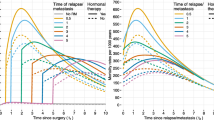Abstract
We consider linear combinations of “natural” timescales and choose the “best” one which provides the minimum coefficient of variation of the lifetime. Our time scale is in fact a generalized Miner time scale because the latter is based on an appropriate weighting of the times spent on low and high level loadings. The suggested modus operandi for finding the“best” time scale has many features in common with the approach suggested by Farewell and Cox (1979) and Oakes (1995) which is devoted to multiple time scales in survival analysis.
Similar content being viewed by others
References
J. W. Dally and G. A. Panozza, “Conductive polymers of fatigue-damage indicators,” Experimental Mechanics vol. 12 pp. 124–129, 1972.
V. T. Farewell and D. R. Cox, “A note on multiple time scales in life testing,” Appl. Statist. vol. 28 pp. 73–75, 1979.
I. Gertsbakh, Models of Preventive Maintenance, North-Holland, 1977.
I. Gertsbakh and Kh. B. Kordonsky, Models of Failures, Springer-Verlag, 1969.
J. Keilson, Markov Chain Models—Rarity and Exponentiality, Springer-Verlag: Berlin, 1979.
Kh. B. Kordonsky, “Linear calculus of degradation time,” Reliab. and Quality Controlvol. 11, pp. 6–18, 1984 (in Russian).
Kh. B. Kordonsky and I. B. Gertsbakh, “Choice of the best time scale for system reliability analysis,” Europ. J. Operat. Res. vol. 65 pp. 235–246, 1993.
Kh. B. Kordonsky and I. B. Gertsbakh, “Best time scale for age replacement,” Intern. J. Reliab. and Safety Engineering vol. 1 pp. 219–229, 1994.
Kh. B. Kordonsky and I. B. Gertsbakh, “System state monitoring and lifetime scales—I, II,” Reliability Engineering and System Safety vol. 47 pp. 1–14, 1995 and vol. 49 pp. 145–154, 1995.
Kh. B. Kordonsky and V. Rastrigin, “Random censoring on trajectories in phase space,” Soviet J. Comput. Systems Sci. vol. 23 pp. 134–140, 1985.
J. Lawless, J. Hu and J. Cao, “Methods for the estimation of failure distributions and rates from automobile warranty data,” Lifetime Data Analysis vol. 1 pp. 227–240, 1995.
M. A. Miner, “Cumulative damage in fatigue,” Journal of Applied Mechanic vol. 12 pp. A159–A164, 1945.
D. N. P. Murthy, B. P. Iskandar and R. J. Wilson, “Two-dimensional failure-free warranty policies: Two-dimensional point process models,” Operations Research vol. 43, no. 2 pp. 356–366, 1995.
D. Oakes, “Multiple time scales in survival analysis,” Lifetime Data Analysis vol. 1 pp. 7–18, 1995.
J. Schijve and F. Jakobs, “Program-Fatigue Test on Notched Light Alloy Specimen of 2024 and 7075 Material,” Techn. Report M 2070, National Res. Inst., Amsterdam, 1960.
Author information
Authors and Affiliations
Rights and permissions
About this article
Cite this article
Kordonsky, K.B., Gertsbakh, I. Multiple Time Scales and the Lifetime Coefficient of Variation: Engineering Applications. Lifetime Data Anal 3, 139–156 (1997). https://doi.org/10.1023/A:1009657101784
Issue Date:
DOI: https://doi.org/10.1023/A:1009657101784




